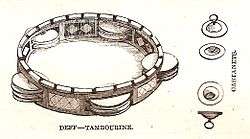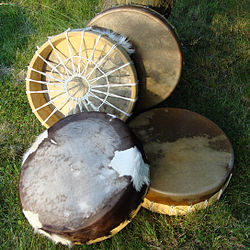Timbrel
The timbrel or tabret (also known as the tof of the ancient Hebrews, the deff of Islam, the adufe of the Moors of Spain) was the principal percussion instrument of the ancient Israelites. It resembled either a frame drum[2] or a modern tambourine.[3]
 Judean deff[1] | |
| Percussion instrument | |
|---|---|
| Other names | adufe, deff, tabret, tof |
| Classification | Frame drum |
| Hornbostel–Sachs classification | 211.311 (Directly struck membranophone) |
History
The word timbrel is used in the Hebrew Bible in both singular and plural form, so as to suggest the former referred to a hoop of wood or metal over which was stretched a parchment head; while the latter was perhaps used to designate the tambourine with bells or jangles fixed at intervals in hoops. In Nahum 2:7, where the word "tabering" occurs, it means beating on the breast, as drummers beat on the tabret. The Israelites learned to use the timbrel during their sojourn in Egypt, and in the eleventh edition of the Encyclopædia Britannica Kathleen Schlesinger stated "it has been suggested that as the Egyptians used it to scare away their evil spirit Typhon",[3] the word tof is derived from the latter. The tabret or timbrel was a favorite instrument of the women, and was used with dances, as by Miriam, to accompany songs of victory, or with the harp at banquets and processions; it was one of the instruments used by King David and his musicians when he danced before the Ark of the Covenant. It was also used in the valley of Hinnom at the sacrificial rites.[3]
See also
Notes
- Thomson, W. M. (1859). The Land and the Book; or Biblical Illustrations Drawn from the Manners and Customs, the Scenes and Scenery of the Holy Land, Volume II. New York. p. 579.
- Sendry 1969.
- Schlesinger 1911.
References

Further reading
- Lewis, Bernard, ed. (1976). The World of Islam, Faith, People and Culture.
- Marcuse, Sibyl (1975). Musical Instruments: A Comprehensive Dictionary. New York: W. W. Norton. ISBN 0-393-00758-8.
- Sadie, Stanley; Tyrrell, John; Macy, Laura, eds. (2001). The New Grove Dictionary of Music and Musicians (2nd ed.).
- Sadie, Stanley, ed. (1980). The New Grove Dictionary of Music and Musicians. Vol. 6 Entry "Frame drum" (1st ed.). p. 739.
